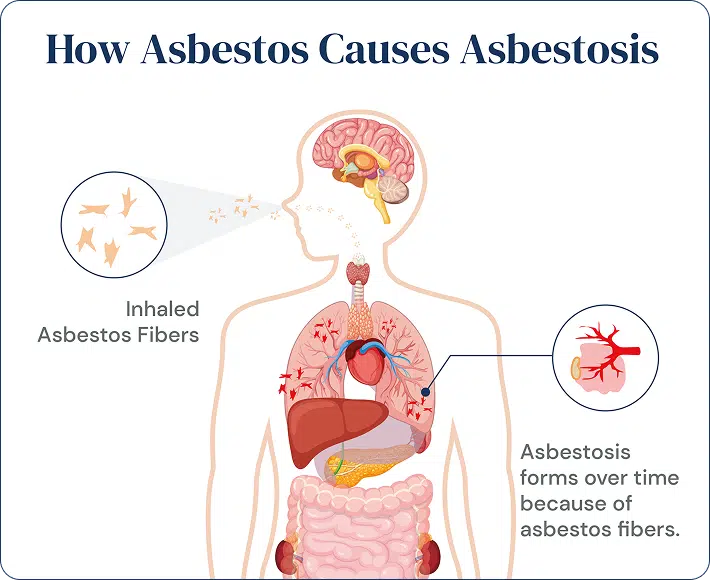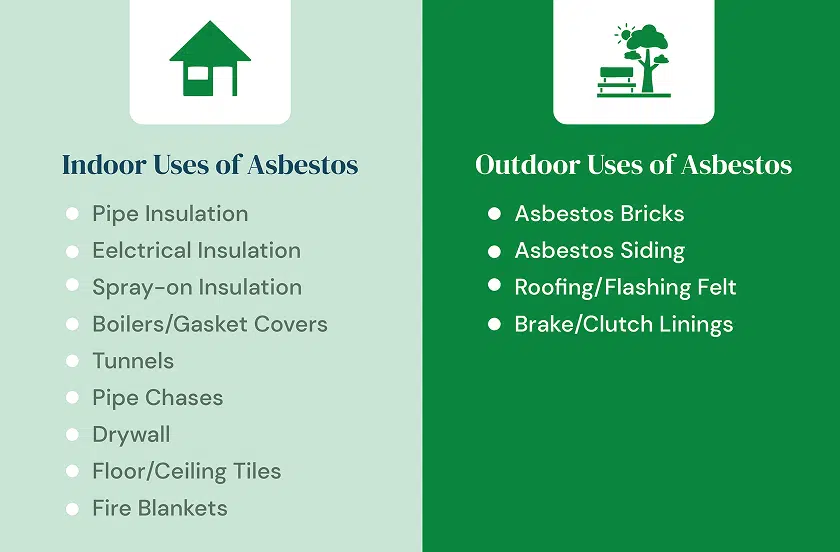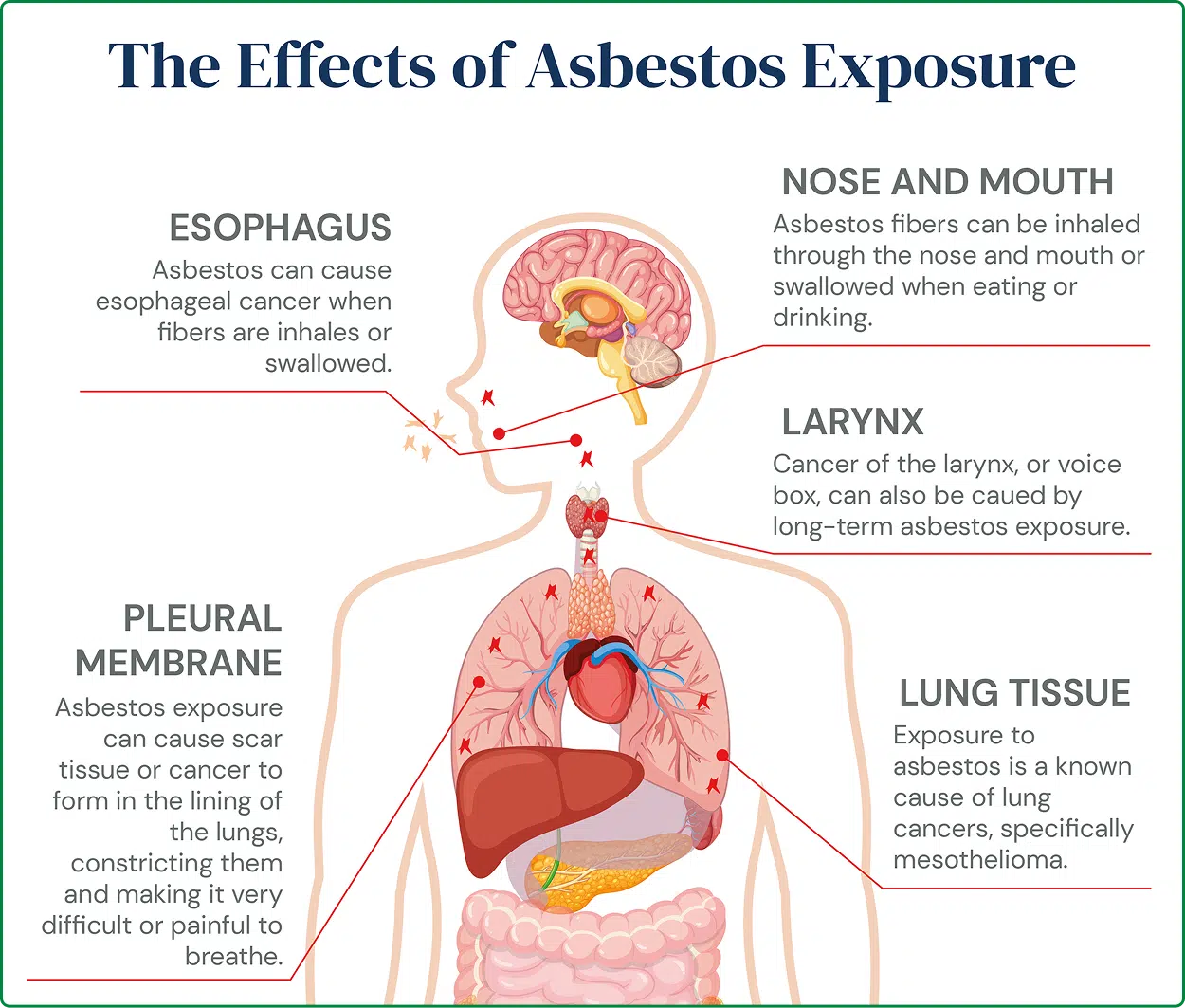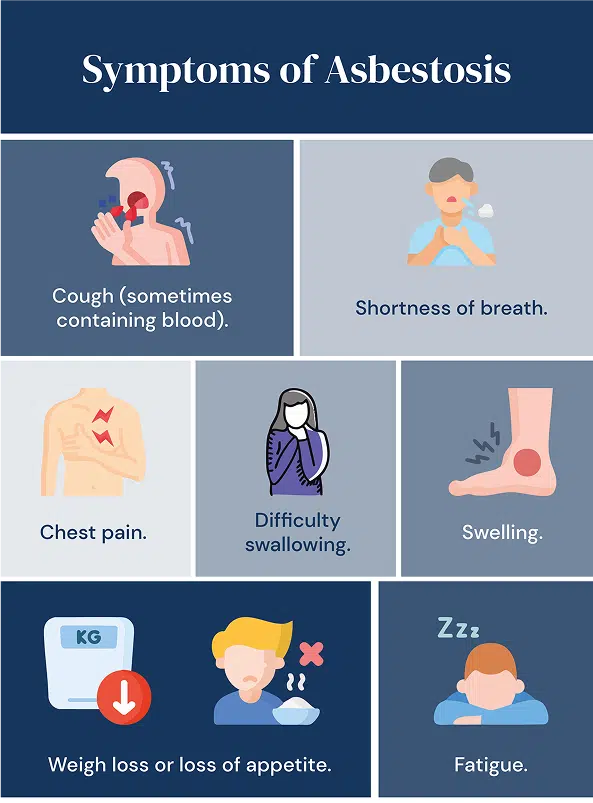Asbestos Exposure
Asbestos exposure is known to cause serious illnesses, including mesothelioma, lung cancer, and asbestosis. Asbestos is a fibrous mineral that was widely used in shipyards, power plants, paper mills, nuclear facilities, and oil refineries. These diseases result when someone exposed to asbestos inhales or ingests the material’s fibers, which can become lodged in bodily tissue. This commonly happens after handling products containing asbestos at home or work.
At Oslund Udo Little, we understand the toll an asbestos-related medical diagnosis can take on your family. We are here to guide you through the legal process with patience and compassion and fight for the compensation you deserve.
- Asbestos was a common component of countless products and industrial materials because of its heat and fire-resistant properties.
- Workers and consumers exposed to asbestos are at risk of developing mesothelioma, lung cancer, and other severe diseases.
- Victims and surviving family members may be entitled to pursue legal action against companies responsible for asbestos exposure.
What Is Asbestos Exposure?
Asbestos is a naturally occurring mineral known for its durability and heat-resistant properties. Because of its usefulness and affordability, it was used in countless applications throughout the 20th century by many industries, including construction, shipbuilding, the military, and manufacturing.
When undisturbed, asbestos poses little risk to humans. However, problems arise when asbestos is disturbed, crushed, agitated, or transformed from its natural state. Such actions release tiny, near-invisible asbestos fibers into the air.
Anyone within range of disturbed asbestos can inhale or ingest the microscopic fibers. The fibers become embedded in the tissue lining bodily organs, such as the lungs and abdomen, potentially causing harmful scarring and inflammation. Over time, mesothelioma or other deadly diseases can develop.

Individuals are exposed to asbestos when asbestos materials are friable and that material is disturbed in a way that releases the asbestos fibers into the air, which happens in many different settings like shipyards and industrial sites. It can also happen through certain consumer products, and when those fibers, which are invisible, are released into the air, the individual, without their knowledge, breathes those in and they become lodged in the lungs and can cause asbestos-related diseases.
– Brendan Little, OUL Partner
What Products Contained Asbestos?
Until the 1980s, asbestos products were widely used in many industrial settings. Manufacturers incorporated it in boilers, furnaces, tanks, and even protective clothing.
Homes built before 1990 may contain asbestos. The substance used in attic insulation, older paint, and floor tiles. Interior heating and cooling systems may also include asbestos-based components.
Common consumer goods can also be a source of asbestos. One example is cosmetics containing talc, such as face powder. Talc naturally occurs near asbestos and is commonly tainted with the toxic substance. Pre-1980 kitchen appliances like ovens may also contain asbestos.

What Is Secondhand Asbestos Exposure?
Exposure doesn’t always come from direct handling of asbestos-containing products. Some people are exposed to the fibers through secondary exposure.
In secondary exposure cases, a family member who works with asbestos products unknowingly transports the tiny fibers home on their clothing and skin. Anyone in their household may inhale the asbestos and develop an illness years later.
Secondary or household exposure to asbestos typically occurs when Dad comes home from work still wearing his work shirt or coveralls. He walks in the door, gives his wife a hug and a kiss, plops down on the couch, and the kids come crawling over, ready to hug him.
“Unfortunately, that’s the kind of situation where invisible asbestos fibers can transfer to the children or the wife, and they breathe them in. Thirty, forty, or even fifty years later, the wife or one of the kids might develop mesothelioma.
– Vanessa Firnhaber Oslund, OUL Partner
Health Risks of Asbestos Exposure
The Agency for Toxic Substances and Disease Registry attributes asbestos exposure to the development of mesothelioma and asbestos lung cancer. Inhaled asbestos fibers can embed themselves within the delicate membranes of the airways or lungs. The fibers cause irritation and scarring, which can encourage tumor growth.
The National Cancer Institute recognizes that all types of asbestos pose health risks. However, amphibole forms of asbestos may pose a greater risk of mesothelioma because they remain in the lungs for longer periods.
Asbestos-related diseases have long latency periods. People who inhale or ingest asbestos fibers often do not show signs of disease for decades. During that time, asbestos fibers can cause irreversible damage to the body, eventually resulting in a life-threatening, untreatable cancer.
Sometimes, people develop non-cancerous conditions such as asbestosis and pleural disease. Asbestosis involves inflammation and scarring of the lungs that causes shortness of breath. These asbestos-related diseases typically get progressively worse, even with medications and treatment to manage symptoms.

Mesothelioma: A Life-Threatening Disease Caused by Asbestos
Mesothelioma is a very rare form of cancer closely connected to asbestos exposure. The disease’s only confirmed cause is asbestos exposure. According to the American Cancer Society, approximately 8 of every 10 people diagnosed with mesothelioma have a history of asbestos exposure.
Nearly 3,000 people in the United States are diagnosed with mesothelioma annually. Most people find out they have the disease in their later years, with the average diagnosis occurring at age 72.
The most common type of mesothelioma is pleural, which affects the lung tissues. Less-common mesotheliomas can impact the stomach, heart, and testicles.
Treatment for mesothelioma may include surgery, chemotherapy, and radiation therapy. However, there is no specific cure for the disease. As an aggressive cancer, it may spread quickly.
Is There a ‘Safe’ Level of Asbestos Exposure?
According to the Occupational Safety and Health Administration, there is no “safe” level of asbestos exposure. People have developed mesothelioma even though their exposure lasted only a few days or weeks. The risk increases substantially with repeated asbestos encounters.
Symptoms of Asbestos Exposure
Affected individuals may not begin to show asbestos exposure symptoms for up to 60 years. A longer latency period is more common among people with less exposure. Higher levels of asbestos exposure may lead to symptoms developing sooner.
Early signs of mesothelioma and other asbestos-related diseases include a persistent cough, wheezing, and vocal hoarseness.
As the illness evolves, symptoms can include chest pain, trouble swallowing, and facial or neck swelling. Victims may not feel hungry, and their weight may drop substantially. Some people feel constantly tired, no matter how much sleep they get.
Often, asbestos-related diseases take many decades to develop. In mesothelioma, the amount of time that the disease takes to develop is often 20 years or more from when the exposure occurred. For that reason, many of our clients were exposed to asbestos in the ’60s or ’70s or even earlier and did not develop mesothelioma until 20, 30, 40 or sometimes 50 years after that exposure occurred.
– Brendan Little, OUL Partner

The Legal Rights of Asbestos Exposure Victims
Companies knew of the dangers of asbestos as far back as the 1920s. However, many organizations continued to use it in their products because of its availability, low cost, and utility. Beginning in the 1960s and 1970s, several high-profile lawsuits against major asbestos producers succeeded, paving the way for future claims.
If you have developed mesothelioma, asbestosis, or another asbestos-related disease, you may be eligible for compensation through a personal injury lawsuit. Surviving family members of asbestos exposure victims may seek compensation through wrongful death litigation.
Potential sources of compensation include asbestos trust funds. From the 1980s into the 2000s, many companies sought bankruptcy protection due to ongoing asbestos litigation. As a condition of their reorganizations, the courts ordered them to establish asbestos trust funds to compensate victims. Depending on your history of exposure, you may be eligible to seek compensation through one or multiple trust funds.
The experienced attorneys at Oslund Udo Little can explain your legal options. Contact us to schedule a free case evaluation with our knowledgeable team.
Statute of Limitations on Asbestos Exposure Claims
Asbestos exposure takes time to manifest as disease. For that reason, the statute of limitations doesn’t start until one of the following occurs:
- The affected person receives a diagnosis of an asbestos-related illness.
- The affected person should have reasonably known you had an asbestos-related illness.
- The affected person dies, entitling a family member to take legal action.
In Oregon, the statute of limitations for personal injury cases is two years from discovering your illness. Wrongful death claims brought by a family member have a statute of limitations of three years after a victim dies.
Washington state has a three-year statute of limitations for personal injury and wrongful death claims stemming from asbestos exposure.
Can You Sue for Asbestos Exposure Before Getting Sick?
Your likelihood of developing mesothelioma substantially increases if:
- You have a history of working with asbestos.
- You live or lived with someone who handled the substance.
However, you generally can’t file an asbestos lawsuit before receiving a diagnosis. That’s because you must show that your exposure caused harm and recoverable damages.
If you believe you’re at risk of developing an asbestos-related disease, look for symptoms such as increased coughing or shortness of breath. Stay on top of doctor’s visits, and inform your physician of your asbestos exposure history. They can monitor you for signs of illness and order additional tests if necessary.
If you have developed a disease, speak with our attorneys to discuss your rights and options.
How Oslund Legal Can Help Asbestos Exposure Victims
Our attorneys have over 20 years of experience fighting on behalf of asbestos exposure victims. As a small firm with a narrow focus, we deliver hands-on, personalized legal services with your needs in mind.
Our case results speak for themselves—we have won over $1 billion in verdicts and settlements for previous clients. In one recent Oregon claim, we obtained a $30 million jury verdict in a wrongful death case. The victim worked for a company that failed to notify its employees that they were handling asbestos fibers.
In a Washington mesothelioma claim, our attorneys won a $5.75 million verdict for a man who worked as a brake mechanic at a Volkswagen dealership during the 1970s. Other notable settlements and verdicts include $10 million for a man who developed mesothelioma through secondary asbestos exposure and $8.3 million for a former electrician.
Contact us today for a free case evaluation with Osmund Udo Little to learn about your mesothelioma compensation options. We’ll work to secure justice for you and your family.
Oftentimes, clients come to us without a clear idea of where or how they were exposed to asbestos. At Oslund Udo Little, we maintain in-depth databases on all of the work sites throughout Washington and Oregon where individuals were historically exposed to asbestos. This allows us to not only look at documents but also testimony from our clients and their co-workers stretching back three decades. This helps us identify where somebody was exposed to asbestos and who might be liable for that exposure.
– Brendan Little, OUL Partner
Our client worked for Ameron’s Bondstrand factory in Brea, California, for four months in 1974 as was exposed to crocidolite asbestos fibers.
Our client worked as a laborer for Zidell Dismantling in the Port Industrial Yard of Tacoma where he was exposed to asbestos-containing insulation removed during the dismantling of former Navy ships.
Verdict for a 79-year-old mesothelioma victim and his wife based on World War II-era secondary asbestos exposures.
He was exposed to asbestos as an electrician in the United States Navy and at Puget Sound Naval Shipyard in Bremerton, Washington.
She was exposed to asbestos products from her father, who worked in telephone line maintenance at Pacific Northwest Bell, now known as CenturyLink.
Our client worked at Atlas Foundry in Tacoma, Washington, where he was exposed to asbestos-containing insulation materials used in metal molds and to talc products.
$5.75 million jury verdict against Volkswagen Group of America and Volkswagen AG for the mesothelioma death of a Spokane man.
He worked as a painter’s helper onboard the USS Ranger at Puget Sound Naval Shipyard from 1975 to 1976.
He was exposed to asbestos when working onboard ships at Hunter’s Point Naval Shipyard in San Francisco, California, and at Puget Sound Naval Shipyard in Bremerton, Washington.
He was exposed to asbestos from his father, who worked as a pipefitter at Todd and Lockheed Shipyards and carried asbestos home on his clothing and person.
Asbestos Exposure Frequently Asked Questions
What Is Asbestos and Why Is It Dangerous?
Asbestos is a fibrous mineral mined from rock. Due to its heat-resistant qualities, asbestos was used extensively in industry, including on board ships, for thermal insulation. Asbestos was also used as a binder in numerous drywall and cement products.
In its inert form, asbestos is not dangerous. However, when it is cut or disturbed, asbestos releases millions of microscopic fibers into the atmosphere. When inhaled deep into the lungs, these fibers can cause irreversible harm.
What Should I Do If I Was Exposed to Asbestos?
High levels of asbestos exposure can cause asbestosis. The risks of developing asbestos lung cancer or mesothelioma are relatively low—less than 10 percent—even for heavily exposed workers, but the risk is lifelong and increases with age. People who experience long-term asbestos exposure have a higher chance of developing asbestos lung cancer, mesothelioma, and other asbestos-related diseases.
What Are the Symptoms of Asbestos Exposure?
Asbestos exposure in low amounts doesn’t cause any immediate health consequences. Illness takes time to develop. Early symptoms of an asbestos illness include a persistent cough, shortness of breath, and abdominal bloating.
How Long Does It Take for Asbestos-Related Diseases to Develop?
Diseases related to asbestos exposure have a long latency period. Victims may not show symptoms for 30 to 40 years after an initial exposure.
Can I Sue for Asbestos Exposure Before I’m Diagnosed With Mesothelioma?
Personal injury claims require you to demonstrate harm or damages to be successful. Without a mesothelioma diagnosis, it’s difficult to prove an asbestos exposure claim.
What Types of Cancer Are Caused by Asbestos Exposure?
Mesothelioma and lung cancer can be caused by asbestos exposure. Cancer of the larynx or ovary may also occur.
How Can I File an Asbestos Exposure Lawsuit?
A qualified attorney can review your case and take legal action against negligent manufacturers and other businesses. Your lawyer can explain other options, such as filing a personal injury lawsuit or a claim with an asbestos trust fund.
Is Asbestos Illegal?
In March 2024, the U.S. Environmental Protection Agency announced a final rule prohibiting ongoing uses of chrysotile asbestos, the only known form currently used in or imported to the United States. However, many other countries still produce and export asbestos.
Who Is Responsible for My Asbestos Injury?
Under the laws of Washington and Oregon, every company that manufactured and supplied an asbestos product to which you were exposed may be liable for your asbestos injury. Thus, one of the biggest challenges is identifying the manufacturers of the asbestos products to which you were exposed.
We have detailed product identification information on hundreds of job sites in Washington, Oregon, and Alaska, as well as hundreds of Navy vessels. Even if you do not know the manufacturers of the asbestos products you worked around, we can probably identify some of the products you may have been exposed to based on the job sites where you worked.
Why Are Asbestos Companies Responsible After So Many Years?
Although the dangers of asbestos were well-known in the medical community by the 1930s, asbestos was manufactured and used in industry and construction until the mid-1970s. These companies understood that there was a lot of money to be made distributing asbestos products, and they were confident that the illnesses would develop so long after the individuals were exposed to their products that they would never be held responsible.
How Much Asbestos Exposure Causes Mesothelioma?
There is no safe level of asbestos exposure. Most people who develop mesothelioma have had significant, prolonged, and repeated exposure to asbestos fibers. However, some have received a mesothelioma diagnosis years after having just a few days of asbestos exposure.





